Plantation Beach Resort, HondurasContents of this Issue: Plantation Beach Resort, Honduras Dive Kararu and the Seahorse Break Ties, Exchange Words, Offer Deals Thailand, Cocos, Hawaii, Maldives... Are Vegetarians More at Risk for DCS? How Divers Can Help the Florida Keys Court Rules Dive Release is “Too Specific” Diving More Deadly Over Age 50? Planning a Dive Trip during Hurricane Season? Editorial Office: Ben Davison Publisher and Editor Undercurrent 3020 Bridgeway, Suite 102 Sausalito, CA 94965 diving on the quiet side of the Bay Islands, in Cayos Cochinos from the August, 2010 issue of Undercurrent
Dear Fellow Diver: I was in a bad mood. Delta had fumbled the luggage transfer at its Atlanta hub but even worse, I was on my short connector flight to La Ceiba, Honduras, in pouring rain and blustery northerly winds. That was the layover point for the next morning’s 15-mile boat trip to Cayo Grande, the largest island in the Cayos Cochinos (Hog Islands) archipelago. My mood meter dropped even farther when Plantation Beach Resort manager Roger Remington, who met me and my partner at the bar of La Ceiba’s Gran Paris Hotel, gave me his weather report. “I don’t like the looks of it,” he said. That’s the peril of December-January travel to Honduras’ Bay Islands (Cayos Cochinos are tucked in between them and the country’s northern coast). But the next morning, the rain petered out and the wind turned. As we departed in a big panga from the beach in the nearby village of Sambo Creek, a pod of dolphins surrounded us in the surf zone. The panga captain called it the welcoming committee, and it was a mood changer.
Plantation Beach Resort (PBR) is just 25 miles from
Roatán but a world apart. You won’t find a cruise ship,
a disco or even a gift shop. Only a few divers and touring
yachties stop off at the only hotel on the postcardperfect
jungly island. Cayo Grande has a few hundred residents
and some scattered
vacation homes,
but you’ll be mostly
isolated, unless you
take a walk over the
hill to the village.
Mainly, you’ll be surrounded
by natural
beauty overlooking the
Caribbean and healthier
reefs than the
nearby islands. This
is no fancy resort:
not a lawn in sight and the only TV was never on. An hour after settling into my hillside cabaña, I, my buddy and our guide were cruising around a coral head at Lion’s Head when we came upon a hawksbill turtle. I laughed out loud. A pesky damselfish was pecking the big guy on the nose! These days, you have to look for those kinds of scenes to add excitement to dives because as we well-traveled divers know, most creatures throughout the Caribbean that can serve as human food are hooked and cooked long before maturity. But there was plenty of good macro stuff to keep me interested. I found three species of shrimp and a pretty spotted lobster. I eased my finger up to a corkscrew anemone to get it cleaned by a Pederson shrimp but the little critter ignored it. The divemaster tried to show me how it’s done, but all he got was a noisy crackle from a hidden snapping shrimp. A couple of swim-throughs later -- one filled with glassy sweepers -- I wandered off the low wall to the sand flats, enjoying the yellow goatfish, garden eels and a tiny-eyed flounder. My buddy pointed to a mound of sand erupting like a miniature volcano; it was a southern lugworm blowing out excreted sand. After 60 minutes, I hung at 15 feet, watching a small barracuda herd creole wrasse over the dead elkhorn coral. The routine is two dives in the morning, with an hour interval spent on the 42- foot dive boat, and an afternoon dive at 2 p.m. The boat is tied to moorings for most dives, adding an occasional drift dive. There are racks for 44 tanks but captain Danny Chacon told me there rarely are more than 10 divers. The dive platform has a big ladder. Crew provides towels and drinking water, and there is a DAN O2 kit on board. No working head and no rinse tank unless you bring a camera on board. The staff loaded our equipment each morning, and rinsed and locked it in the dockside storage room each evening. Air fills were 2,700 to 3,000 psi. Danny, having worked at PBR for many years, knows the reefs well. Mike Wall, the new lead divemaster, previously worked in Roatán (as has Robin Brigham, the other divemaster) and in the Indo-Pacific. What he lacks in experience he makes up for in enthusiasm. There was no time limit imposed, and most dives lasted about an hour, when I ran low on air. (Nitrox isn’t offered.)
The 10-room resort is tucked into a forested creek valley on a cove on Cayo Grande. Some rooms are next to the creek, and a few cabañas are spread along a hillside walkway. Social life is centered in the main lodge, overlooking a small beach and the boat dock. The lodge includes a long room with tables for eating and telling little diver lies, a bar, and a small library with three Paul Humann ID books. Satellite Wi-Fi allows you to surf the net (staff allowed me to use their computer and even borrow a cell phone for a couple of calls to the mainland). But most fun was chatting with an interesting mix of guests; conversation might include English with various accents, Spanish, Portuguese and German. PBR staff stopped by to deal with logistics, or to tell tall ones about wildlife and wilder guests they’ve seen. (I heard more about Cameron Diaz than I wanted to know.)
I made three of my 14 dives along Pelican Wall, near the resort’s front yard. At Pelican 3, I descended to 85 feet to find longsnout butterflies and blackcap basslets, then eased slowly along and up, checking out the grottos and ledges. I followed a large schoolmaster into a crevice and found a five-foot barracuda, blackened and nose-down, getting car-wash treatment from cleaning gobies. Meanwhile, my partner, scouting the small stuff, pointed out giant tunicates, tube tunicates and a variety of anemones and corallimorphs. Mike, who immediately adapted to my slow, poke-around style, found sea slugs and other critters so small that I needed my magnifier to ID them. He pointed at a spectacular five-inch fish with an ostentatious dorsal fin posed on a tiny ledge -- a male quillfin blenny. Tucked in the sand between coral heads was an unusually large, bright green sea cucumber. I turned around to return to the mooring near the top of the reef at 30 feet, enjoying some healthy coral cover here. A school of brown chromis spilled around a pinnacle, with a cowfish trailing them. At a site called Hospital, I cruised over the shallows and down to 80 feet for a wall tour, including a hawksbill moving overhead, a couple of big scorpionfish, a large-eye toadfish (seen on a number of dives) and a spotted moray. Nearby, several arrow blennies stood guard at a little nook. Back up in the shallows, lit by bright sun, I watched red band parrots in a spawning rush, then a couple of wrasses did a prolonged, open-jaw face-off, their macho version of territorial shadow-boxing. Mike found a leopard flatworm. Near the mooring, I saw an octopus in the open, shooting black ink clouds for no reason I could determine. It finally pressed itself against coral, changing into camo coloration. I wanted to ask it why it was so upset. Cayos Cochinos has been a protected preserve since 1993 -- with just local hookand- line fishing -- so the fish life is better than at the bigger Bay Islands. Still, like everywhere in the Caribbean, the reefs are noticeably stressed. I asked Roger, who started at PBR some 15 years ago as a divemaster and has been the manager for several years, why some sites seem relatively healthy and others have heavy algae cover. He pointed out that the healthy reefs are near Cayo Grande (where PBR is located) and some of the smaller cays, and the more stressed reefs are near Cayo Menor, the sister island a couple of miles away. There was a five-year hiatus on diving the Menor sites as part of an ongoing study but it was found that the lack of diving pressure had no effect. The difference remains unexplained. Roger noted that after the five-year period there was some trash on the reefs at Menor because divers weren’t there to pick it up. The healthiest -- and most exciting -- sites are the nearby sea mounts. To my disappointment,
they were not reachable during my January trip due to bumpy seas, which
lowered visibility to 50 feet and limited
some site selections. The resort itself has changed little over the years. There are a couple of newer cabañas, rooms 10 and 12, which I would definitely recommend. Some rooms are spread out but others are close to the lodge. They are plain but spacious and airy, with 24-hour electricity, overhead fan, hotwater shower and a resident gecko. The new ones have a great view from their terraces. Don’t expect maintenance standards of the Cancún El Presidente -- our roof leaked during a heavy downpour but we were quickly moved to a room next door. In addition to the Caribbean Three-Rs -- rum, romance and relaxation -- activities include hiking, kayaking, snorkeling or watching the birds outside my front door. A nice walk leads up along the creek to the island’s 500-foot-high point and a lighthouse view of all the surrounding islands. If you pass local folks, you may hear some Garifuna language as well as Spanish. A PBR staffer helped me find a pink boa constrictor in a tree a short way down the trail; he seemed to know which branches those snakes favor. It’s a subspecies endemic to the island, and the subject of one of my nicest topside photos. I found the PBR staff competent and helpful. When my luggage was lost, they loaned me a shortie, BC and fins, and arranged almost free delivery of my luggage to the island by taxi and then on the next boat coming over. Each meal is served as a plentiful buffet and is pretty good for a remote place. Compliments to the kitchen staff led to smiles and discussions of tomorrow’s possibilities. There’s no menu but you can make your requests by email before you arrive. I requested fresh fish and local dishes (called “tipico” in Honduras), and after some initial complaining, got it. Breakfasts always included fresh fruit and eggs, with pancakes or thick Central American tortillas, and usually bacon. Good coffee was available early. Lunches usually included red beans and rice, with meat or fish, a couple of times with fried green plantains. Dinners were similar. Lunch ends with cookies, dinner with homemade cake or pie. The small bar had plenty of liquor and Honduran beer but don’t expect any fancy drinks. In fact, guests often just pull beer from the cooler and mark their own tabs. Potable water is always available, including in the rooms. There were usually a couple other guests from the U.S., Canada or Honduras visiting at dinner and talking over Salva Vida beers. Roger says January is a slow month. If there were a dozen guests and half of them were on the dive boat, the place would have a livelier feel. Snorkeling is decent in the turtle grass and in-shore corals right off the resort dock but you can do better with a walk or kayak nearby, especially near Pelican Point, in-shore of the Bay Islands Aggressor mooring. You can also make shore dives at night, though Pelican Wall makes a better night dive. It’s hard to get from the U.S. to the island in a day, so PBR arranges a hotel stay in La Ceiba. You can use it as more than a layover: La Ceiba is the gateway to some great day-excursions in the rain forest, incredible birding, monkeys and crocs, or a couple hours of whitewater rafting on the nearby Congrejal River. On this trip, I spent four days in the area with an excellent naturalist guide. A boat tour of the Cuero y Salado wetlands provided outstanding birding and close-up howler monkey troops. Another day, I enjoyed a rainforest hike to a 300-foot waterfall in Pico Bonito National Park. And I met nice people everywhere in Honduras; the few times I approached a stranger and asked to use their cell phone, I was never turned down. If you like getting off diving’s interstates for the less-traveled roads, Plantation Beach Resort might be worth looking at. It’s good diving, a comfortable, laid-back environment and very easy on the budget. -- M.A.
|

I want to get all the stories! Tell me how I can become an Undercurrent Online Member and get online access to all the articles of Undercurrent as well as thousands of first hand reports on dive operations world-wide
| Home | Online Members Area | My Account |
Login
|
Join
|
| Travel Index |
Dive Resort & Liveaboard Reviews
|
Featured Reports
|
Recent
Issues
|
Back Issues
|
|
Dive Gear
Index
|
Health/Safety Index
|
Environment & Misc.
Index
|
Seasonal Planner
|
Blogs
|
Free Articles
|
Book Picks
|
News
|
|
Special Offers
|
RSS
|
FAQ
|
About Us
|
Contact Us
|
Links
|
3020 Bridgeway, Ste 102, Sausalito, Ca 94965
All rights reserved.

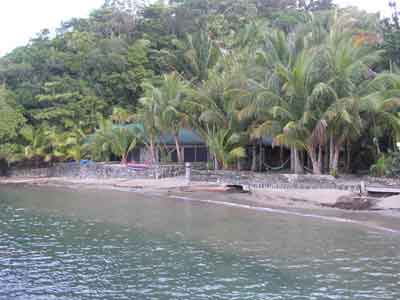
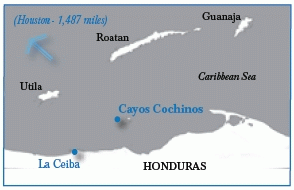 I almost
expected to see Mary Ann and the Professor
coming up the stone walkway.(My apologies
if you don’t remember Gilligan’s Island.)
I almost
expected to see Mary Ann and the Professor
coming up the stone walkway.(My apologies
if you don’t remember Gilligan’s Island.)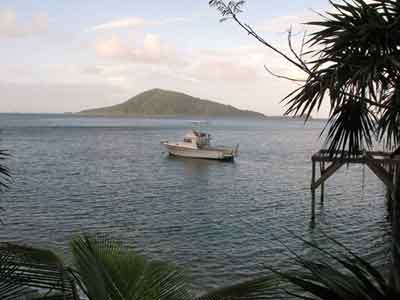
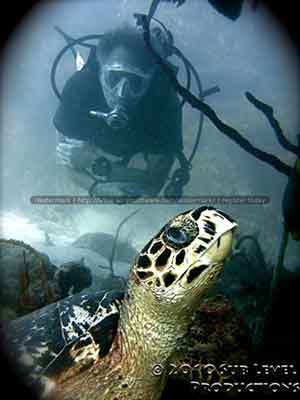
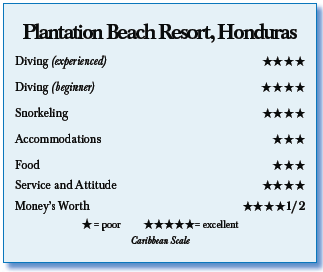 On an earlier
trip to PBR 13 years ago, I made nearly
half my dives on the sea mounts and
found more pelagics, more schools and
more electric diving. I would recommend
spring or summer as the better dive seasons
here, to dodge the rain (and mainland
run-off) and to increase the odds
of diving the banks in calm water.
On an earlier
trip to PBR 13 years ago, I made nearly
half my dives on the sea mounts and
found more pelagics, more schools and
more electric diving. I would recommend
spring or summer as the better dive seasons
here, to dodge the rain (and mainland
run-off) and to increase the odds
of diving the banks in calm water.  Diver’s Compass: I paid $625, double occupancy, ($540 plus 16 percent
tax) for five days of diving, hotel and all-inclusive meals;
this is 10 percent off the rack rate, which I requested by email
. . . Extras: $80 for the round-trip boat trip from La Ceiba, $10
park fee, the bar bill (beer is $3) and tips for the boat and hotel
staff . . . In La Ceiba, I stayed at Gran Paris in the center of
town and paid $43 for a nice double room; PBR can get you 20 percent
off . . . To take land excursions near La Ceiba, contact La
Moskitia Ecoaventuras, run by Jorge Salaverri, an excellent, bilingual
naturalist guide, at
Diver’s Compass: I paid $625, double occupancy, ($540 plus 16 percent
tax) for five days of diving, hotel and all-inclusive meals;
this is 10 percent off the rack rate, which I requested by email
. . . Extras: $80 for the round-trip boat trip from La Ceiba, $10
park fee, the bar bill (beer is $3) and tips for the boat and hotel
staff . . . In La Ceiba, I stayed at Gran Paris in the center of
town and paid $43 for a nice double room; PBR can get you 20 percent
off . . . To take land excursions near La Ceiba, contact La
Moskitia Ecoaventuras, run by Jorge Salaverri, an excellent, bilingual
naturalist guide, at 